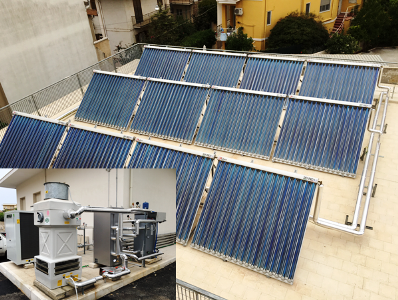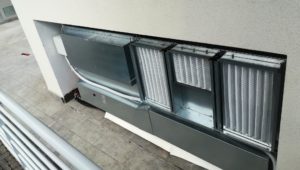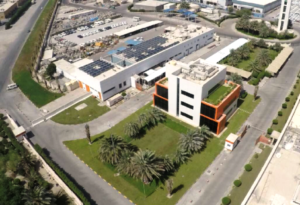Italy: New Solar Cooling Systems and Opportunities
June 7, 2017
 Government incentives have been pushing solar cooling forwards in Italy. The large budget available for national incentive scheme Conto Termico 2.0 has made several service providers optimistic about the future of the Italian market. For example, Mario Colaiemma from Maya, the European distributor of Japanese Yazaki chillers, said that “Italy was the key market for our solar thermal-driven chillers in 2016.” The photo shows a typical solar cooling system based on slightly below 50 m² of vacuum tube collectors connected to a 17.6 kW chiller. It was installed in Sicily, also home to two solar cooling plants by German chiller manufacturer Fahrenheit (formerly Sortech). Gregor Feig, Head of Sales at Fahrenheit, said in March 2017 that “two sorption cooling systems were put into operation in data centres in Enna and Caltanissetta, in the very sunny region of Sicily. Two more systems have been delivered, but haven’t gone online yet.”
Government incentives have been pushing solar cooling forwards in Italy. The large budget available for national incentive scheme Conto Termico 2.0 has made several service providers optimistic about the future of the Italian market. For example, Mario Colaiemma from Maya, the European distributor of Japanese Yazaki chillers, said that “Italy was the key market for our solar thermal-driven chillers in 2016.” The photo shows a typical solar cooling system based on slightly below 50 m² of vacuum tube collectors connected to a 17.6 kW chiller. It was installed in Sicily, also home to two solar cooling plants by German chiller manufacturer Fahrenheit (formerly Sortech). Gregor Feig, Head of Sales at Fahrenheit, said in March 2017 that “two sorption cooling systems were put into operation in data centres in Enna and Caltanissetta, in the very sunny region of Sicily. Two more systems have been delivered, but haven’t gone online yet.”Photo: Maya
Solar cooling plants in Italy are part of the scope of Conto Termico and their owners can receive subsidies of up to 65 % of the investment costs. After regulations were revised in February 2016, even larger installations with a gross area of up to 2,500 m² have become eligible for the programme (previously, the cap was 1,000 m²).
However, the 2015 share of solar cooling and process heat was only 0.5 % of the total of 5,121 systems, which translates into 44,313 m² based on the most recent statistics by Gestore dei Servizi Energetici (GSE), the governmental administrator of the scheme. This means that 2015 saw the government approving subsidies for not more than 26 plants, used either for solar cooling or industrial process heat. Still, a large part of the budget remains available – EUR 191 million (out of EUR 200 million) for public buildings and more than EUR 660 million (out of EUR 700 million) for private-sector ones.
“The main barrier to market growth is the lack of knowledge about the fairly good conditions of Conto Termico 2.0,” explained Colaiemma, whose company set up and put five solar thermal cooling systems into operation in Italy last year.
Technical requirements to apply for solar cooling subsidies
To be eligible for Conto Termico, solar thermal systems must have
- A Solar Keymark collector certificate
- Based on this certificate, a specific yield greater than 300 kWh/m² and year for flat plate collectors and above 400 kWh/m² for evacuated tubes at the Würzburg site and 50 °C
- A metering system if collectors are more than 100 m² in size and data must be sent to GSE each year
There are two more requirements to be met when sizing solar cooling plants:
- The ratio between collector gross area (in m²) and chilling power (in kW) must be between 2 and 2.75.
- If the system employs desiccant cooling, the gross surface area of the collectors must be between 8 and 10 m² per 1,000 m3 and hour of air used.
Subsidy paid in two or five annual instalments
The subsidy amount is paid in two annual instalments for systems below 50 m² and in five for ones between 50 and 2,500 m². The yearly amount in euros (Ia tot) is calculated as follows:
Ia tot = Ci •Qu• Sl
where Sl refers to the system’s gross area, Ci is a parameter containing a value from the table below, and Qu is the annual collector yield (as reported on the Solar Keymark certificate for Würzburg at 75 °C) divided by the gross area of the collector type.
| Sl gross collector area | ≤ 12 m² | 12 ≤ 50 m² | 50 ≤ 200 m² | 200 ≤ 500 m² | 500 ≤ 2,500 m² |
| Ci [EUR/kWh] | 0.43 | 0.39 | 0.13 | 0.12 | 0.11 |
Parameter depending on the gross collector area given in regulations of Conto Termico
A 200 m² (140 kW) solar cooling installation (Cì of 0.13 EUR/kWh) with a collector yielding 370 kWh/m² at 75 °C will receive EUR 9,620 in annual instalments, which will add up to EUR 48,100 in five years. If the design satisfies the rules mentioned above, the system’s cooling load should be between 70 and 100 kWcool. Typical investment costs for larger solar cooling installations average 2,200 EUR/kW, as per the German-based Green Chiller association. Consequently, the EUR 48,100 grant will cover between 22 and 31 % of the investment of EUR 154,000 to 220,000. This is not even half of the promised 65 % grant – probably one of the reasons why the number of solar cooling remains small within Conto Termico.
More information:
Search for #SolarCooling hashtag on Twitter
Search for #SolarCooling hashtag on Twitter
Websites of organisations and programmes mentioned in this news article:
Conto Termico support: http://www.gse.it/it/Conto%20Termico/Conto%20Termico%202.0/Pagine/default.aspx
Solar Keymark certificate: http://www.solarkeymark.org
Fahrenheit: https://fahrenheit.cool/


